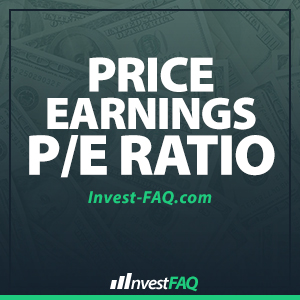 The price earnings ratio, or P/E ratio, measures a company’s share price as compares with its per-share earnings. For example, a Price to Earnings ratio of 10 means that the company has $1 of annual, per-share earnings for every $10 in share price. Earnings by definition are after all taxes, etc.
The price earnings ratio, or P/E ratio, measures a company’s share price as compares with its per-share earnings. For example, a Price to Earnings ratio of 10 means that the company has $1 of annual, per-share earnings for every $10 in share price. Earnings by definition are after all taxes, etc.
What is the P/E Ratio?
Contents
A company’s P/E ratio is computed by dividing the current market price of one share of a company’s stock by that company’s per-share earnings. A company’s per-share earnings are simply the company’s after-tax profit divided by number of outstanding shares. For example, a company that earned $5M in a calendar year, with a million shares outstanding, had earnings per share of $5. If that company’s stock sells for $50/share, it has a P/E of 10. Stated differently, at this price, investors are willing to pay $10 for every $1 of last year’s earnings.
Price Earnings Ratio Formula
The price to earnings formula is calculated below:
Price Per Share / Earnings Per Share
P/E Ratio Equation Components
Price per share – this is the stock price on the date of the calculation
Earnings per share – this is the company earnings divided by the number of shares outstanding
P/E ratios are traditionally computed with trailing earnings (earnings from the past 12 months, called a trailing P/E) but are sometimes computed with leading earnings (earnings projected for the upcoming 12-month period, called a leading P/E). Some analysts will exclude one-time gains or losses from a quarterly earnings report when computing this figure, others will include it.
Adding to the confusion is the possibility of a late earnings report from a company; computation of a trailing P/E based on incomplete data is rather tricky. (I’m being polite; it’s misleading, but that doesn’t stop the brokerage houses from reporting something.) Even worse, some methods use so-called negative earnings (i.e., losses) to compute a negative P/E, while other methods define the P/E of a loss-making company to be zero. The many ways to compute a P/E may lead to wide variation in the reporting of a figure such as the “P/E for the S&P whatever.”
Worst of all, it’s usually next to impossible to discover the method used to generate a particular P/E figure, chart, or report.
PE Ratio Uses
Like other indicators, P/E is best viewed over time, looking for a trend. A company with a steadily increasing P/E is being viewed by the investment community as becoming more and more speculative. And of course a company’s P/E ratio changes every day as the stock price fluctuates.
The price/earnings ratio is commonly used as a tool for determining the value the market has placed on a common stock. A lot can be said about this little number, but in short, companies expected to grow and have higher earnings in the future should have a higher P/E than companies in decline. For example, if Amgen has a lot of products in the pipeline, I wouldn’t mind paying a large multiple of its current earnings to buy the stock. It will have a large P/E. I am expecting it to grow quickly.
Price to Earnings Ratio Example
PE is a much better comparison of the value of a stock than the price. A $10 stock with a PE of 40 is much more “expensive” than a $100 stock with a PE of 6. You are paying more for the $10 stock’s future earnings stream. The $10 stock is probably a small company with an exciting product with few competitors. The $100 stock is probably pretty staid – maybe a buggy whip manufacturer.
It’s difficult to say whether a particular P/E is high or low, but there are a number of factors you should consider. First, a common rule of thumb for evaluating a company’s share price is that a company’s P/E ratio should be comparable to that company’s growth rate. If the ratio is much higher, then the stock price is high compared to history; if much lower, then the stock price is low compared to history. Second, it’s useful to look at the forward and historical earnings growth rate. For example, if a company has been growing at 10% per year over the past five years but has a P/E ratio of 75, then conventional wisdom would say that the shares are expensive. Third, it’s important to consider the P/E ratio for the industry sector.
For example, consumer products companies will probably have very different P/E ratios than internet service providers. Finally, a stock could have a high trailing-year P/E ratio, but if the earnings rise, at the end of the year it will have a low P/E after the new earnings report is released. Thus a stock with a low P/E ratio can accurately be said to be cheap only if the future-earnings P/E is low. If the trailing P/E is low, investors may be running from the stock and driving its price down, which only makes the stock look cheap.
Article Credits:
Contributed-By: E. Green, Aaron Schindler, Thomas Busillo, Chris Lott
